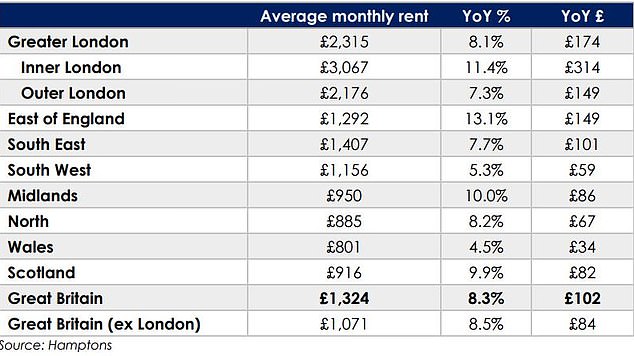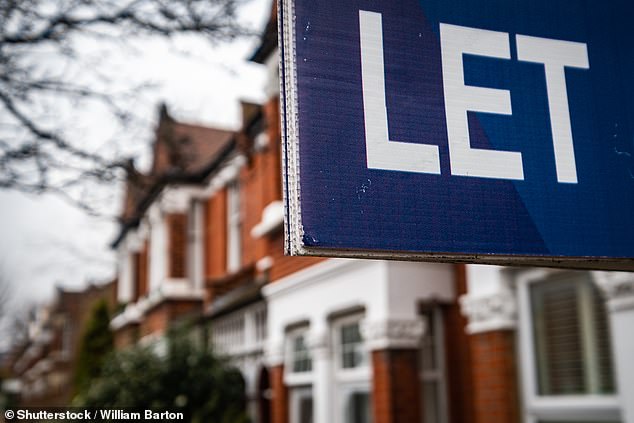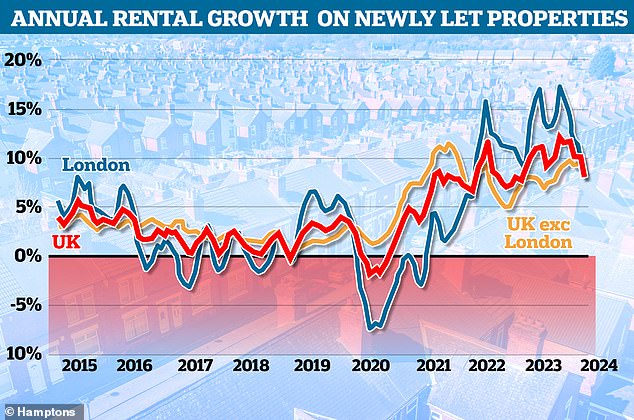Table of Contents
After three years of double-digit rent increases, the rental market finally appears to be cooling.
Rental prices in the UK have fallen for the third month in a row, according to the HomeLet Rental Index. This index uses tenant benchmark data from more than one million tenants each year.
It shows that in January average rents fell 0.6 per cent, following a 0.9 per cent drop in December. Since October, the average rent has fallen from a high of £1,283 a month to £1,260 a month in January.
This follows three years of dramatic monthly increases that boosted the average rent by 32 per cent, from £974 to £1,283 per month between October 2020 and 2023.
HomeLet says all UK regions saw average rents fall in January, except the East Midlands, West Midlands and the South West.
Slowdown: In January, average rents for newly let properties across the UK rose at the slowest pace in 13 months, according to Hamptons.
HomeLet’s figures coincide with data published today by Hamptons.
The property company revealed that average rents for newly let properties rose at their slowest pace in 13 months, up 8.3 per cent year-on-year across the UK.
This marks a change of pace from 2023, when rental growth peaked at 12 percent in August and slowed slightly to 10.2 percent in December.
Hamptons says that last month 59 percent of landlords achieved a higher rent when a new tenant moved in, up from a high of 81 percent in January 2022 and 79 percent in January 2023.
Aneisha Beveridge, head of research at Hamptons, said: “It looks like last summer may have been the peak for rental growth.
‘Since then, fewer and fewer landlords pay rent. When they have done so, in cash terms, the monthly increases have tended to be double figures rather than triple figures.’
We decided to contact several letting agents across the UK to establish if they are also seeing the rental market cooling.
Lorraine Ashelby, director of lettings and property management at Countrywide in Scotland, said: “We have noticed a slight change in rents in central Glasgow and surrounding markets.
‘This market is constantly changing and we currently see the need to lower rents, even if gently.
‘Where we previously saw rents reaching up to 30 per cent above market value due to exceptional demand, we now see demand equaling supply and many tenants are unwilling to pay more than market value.
‘In addition, tenants expect a very well-presented property if they pay the highest final prices demanded in the city.
“In our outlying branches stretching from the west coast to Dundee, the change in rent is very subtle and in many areas it remains stable.”

More options: There are 34% more rental homes on the market today than at the same time last year, but 43% fewer compared to the same time in 2019, according to Hamptons.
Angela Davey, lettings director at Peter Alan in Wales, says that while rents continue to rise in cities, rents in smaller towns and rural areas are starting to stabilise.
She says: “Average rents are still at record levels here in Wales, but the latest growth rates were the lowest since before the pandemic, and early signs are that the annual pace of rent growth will slow further in 2024.
‘Despite the current trend of modest rental growth in Wales, specific locations within the country are exhibiting more pronounced fluctuations.
‘In particular, urban centers and areas with high demand for rental properties, such as Cardiff, are experiencing relatively higher rental growth rates.
“On the other hand, rural areas and smaller towns may experience slower rental growth or even stagnation, with growth rates lower than the national average.”
Meanwhile, Matthew Hardwick, director of William H Brown’s lettings branch in Lincoln, says rental demand is largely dependent on the type of property.
Hardwick says: ‘In the Lincoln area we are still seeing an overall increase in rents, however we are finding that certain types of properties may see slight reductions simply due to lower demand.
‘For example, a larger house with four or five bedrooms is currently in less demand and is therefore more likely to see a price reduction than a two or three bedroom property; These are our core properties whose rents continue to rise as there is much more competition among tenants.’
Why are rents falling?
Over the past three years, there has been a lot of talk about the fact that there is not enough housing available for rent to meet growing tenant demand.
However, it appears that this imbalance is finally starting to tip in favor of renters.
Hamptons says there are 34 percent more rental homes on the market today than at the same time last year.
This is primarily a reflection of the longer time it takes to rent a property, rather than a large increase in the number of new rental homes coming to the market.
However, there remains a shortage. For example, there are still 43 percent fewer homes for rent compared to the same period in 2019, before rents began to skyrocket.
‘The magnitude of mortgage rate increases fueled two years of record rental growth. As landlords have moved away from fixed terms, they have been partly passing these higher costs onto tenants in the form of higher rents.
‘While upward pressure on rents looks set to weaken in 2024, especially since mortgage rates have fallen, broader pressures on landlords mean rental growth will remain stubbornly sticky.
‘Reduced yields, together with the additional time and financial costs arising from rental reform, have reduced the number of new landlords. “This looks set to keep rental growth ahead of inflation this year.”
Falling rents in London lead the way
The rental market in the capital appears to be currently cooling the fastest.
Annual rental growth in the capital more than halved between August and January, falling from 17.1 per cent to 8.1 per cent, according to Hamptons, meaning it recorded the slowest rental growth in two years.
The average monthly rent for a property in Greater London has fallen by more than £100 per month from a peak of £2,192 per month in October to £2,081 per month in January, equivalent to a 5 per cent drop.
Once again, an increasing number of available rental homes is likely to be helping to drive down prices in the capital.
According to London estate agent Chestertons, there are currently 41 percent more rental properties available in London than in January 2023.
With more properties on the market, renters enjoy more options and are under less pressure to make a decision quickly.

They continue to rise: although average rents have fallen, they are still much higher than a year ago
Data from Rightmove backs this up, showing that the average time a property appears on the platform before being rented or put up for offer has increased from 33 to 39 days.
This has led to more landlords slashing sales prices to attract tenants.
Adam Jennings, head of lettings at Chestertons, says: “We have seen a significant increase in the number of landlords bringing their properties to the market, attracted by substantial rent increases over the last 18 months or so.”
‘This influx of properties has led to more options for tenants and, as a result, many landlords have decided to reduce their rental expectations.
‘We anticipate that the number of available rental properties will continue to grow in 2024, causing rental levels to tighten further.
“This creates more beneficial market conditions for tenants, however, London still has one of the most competitive rental markets around and we advise tenants to start their search as soon as possible.”
What’s next for rental prices?
Despite the positive news for renters, HomeLet’s experts believe this is not the start of a downward trend.
In fact, HomeLet experts still predict that rental costs could rise by a further 5 to 10 percent until January 2025.
Andy Halstead, CEO of HomeLet and Let Alliance, says: “While we can be absolutely positive about these developments in the short term, it is not yet time to celebrate.”
‘On the one hand, it is fantastic to see rental prices continuing to fall month on month and by the largest amount in years.
“But, on the other hand, we also know the market and are very aware of the external factors that may affect it in the coming months.”

HomeExperts continue to predict that rental costs could rise a further 5 to 10 percent through January 2025
Halstead adds: “Of course, marginally lower rents put a little more money in tenants’ pockets and partially reduce the likelihood of defaults, but the broader picture remains incredibly challenging for all parties, with little sign of letting up.” improvement”.
‘In fact, going by last year’s trajectory, it is quite possible that rents will be 5 or 10 per cent higher by this time next year.
«Unless we see some dramatic changes in the economy, it looks like 2024 will bring more of the same.
‘Landlords will have to contend with a host of familiar struggles, including rising costs and prohibitively expensive buy-to-let mortgage rates.
“I will be watching the spring budget next month to see what kind of support will be offered to tenants and landlords.”
Some links in this article may be affiliate links. If you click on them, we may earn a small commission. That helps us fund This Is Money and keep it free to use. We do not write articles to promote products. We do not allow any commercial relationship to affect our editorial independence.




